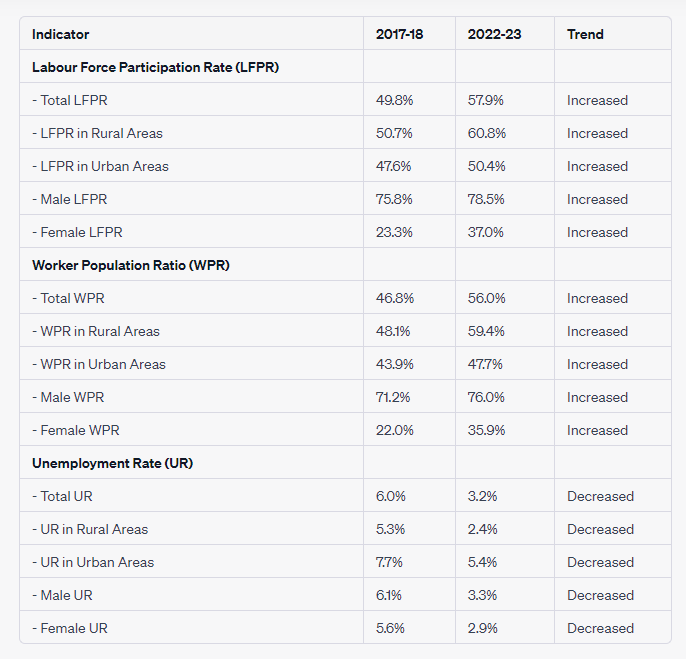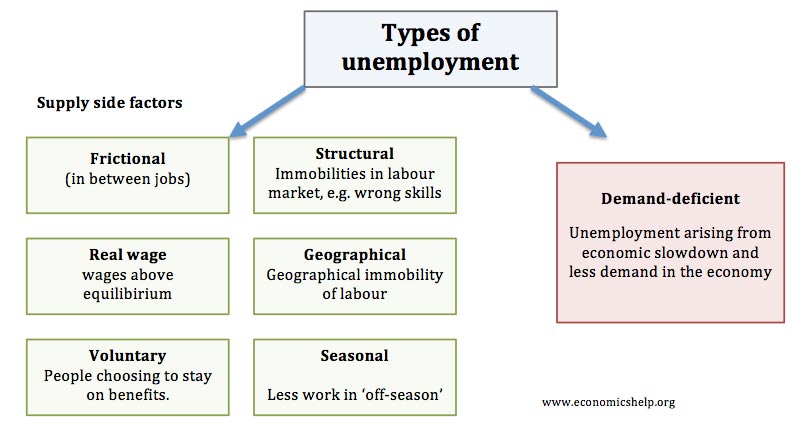PLFS Annual Report 2022-2023
2023 OCT 23
Mains >
Economic Development > Indian Economy and issues > Employment
WHY IN NEWS?
Recently, the National Statistical Office (NSO) released the Periodic Labour Force Survey (PLFS) Annual Report 2022-2023.
ABOUT PLFS
- It is a survey conducted by the NSO under the Ministry of Statistics and Programme Implementation (MoSPI) to measure the employment and unemployment situation in India.
- The NSO launched the PLFS in April 2017.
OBJECTIVE OF PLFS:
- To estimate the key employment and unemployment indicators (viz. Worker Population Ratio, Labour Force Participation Rate, Unemployment Rate) in the short time interval of three months for the urban areas only in the ‘Current Weekly Status’ (CWS).
- To estimate employment and unemployment indicators in both ‘Usual Status’ and CWS in both rural and urban areas annually.
KEY FINDINGS OF THE PLFS REPORT:

KEY TERMS
Unemployment
- It occurs when a person who is actively searching for employment is unable to find work.
- NSO defines employment and unemployment on the following activity statuses of an individual:
- Working (engaged in an economic activity) i.e., 'Employed'.
- Seeking or available for work i.e., 'Unemployed'.
- Neither seeking nor available for work.
The first two constitute the labour force and unemployment rate is the percent of the labour force that is without work.
Unemployment rate = (Unemployed Workers / Total labour force) × 100.
Labour Force Participation Rate (LFPR):
- LFPR is the percentage of the working-age population (aged 15 years and above) that is either employed or unemployed, but willing and looking for employment.
Worker Population Ratio (WPR):
- WPR is defined as the percentage of employed persons in the population.
Unemployment Rate (UR):
- UR is defined as the percentage of persons unemployed among the persons in the labour force.
Activity Status
- The activity status of a person is determined on the basis of the activities pursued by the person during the specified reference period. When the activity status is determined on the basis of the reference period of the last 365 days preceding the date of the survey, it is known as the usual activity status of the person.
Types of Activity Status:
Principal Activity Status (PS):
- The activity status on which a person spent a relatively long time (major time criterion) during 365 days preceding the date of the survey, was considered the usual principal activity status of the person.
Subsidiary Economic Activity Status (SS):
- The activity status in which a person in addition to his/her usual principal status, performs some economic activity for 30 days or more for the reference period of 365 days preceding the date of survey, was considered the subsidiary economic activity status of the person.
Current Weekly Status (CWS):
- The activity status determined on the basis of a reference period of the last 7 days preceding the date of the survey is known as the current weekly status (CWS) of the person.

MAJOR CAUSES OF UNEMPLOYMENT IN INDIA?
- Population Growth: India's rapidly growing population leads to increased competition for jobs, resulting in higher unemployment rates.
- Educational Mismatch: There is often a gap between the skills possessed by job seekers and the skills demanded by the job market. Many graduates are not job-ready.
- Structural Unemployment: Certain industries may be in decline, leading to structural unemployment. This can be caused by technological advancements, changing consumer preferences, or global economic trends.
- Lack of Skill Development: Many Indians lack relevant job skills, especially in industries like IT, manufacturing, and healthcare, where demand for skilled labor is high.
- Labor Market Rigidities: Labor laws and regulations can make it difficult for businesses to hire and fire employees, discouraging job creation.
- Underemployment: Many people are employed in low-paying, low-skilled jobs that do not utilize their full potential. This is often seen in the informal sector.
GOVT. SCHEMES TO PROMOTE EMPLOYMENT
- Support for Marginalized Individuals for Livelihood and Enterprise (SMILE): SMILE is a government initiative aimed at empowering marginalized individuals by providing them with opportunities for skill development, livelihood support, and access to credit, fostering economic self-sufficiency and social inclusion.
- PM-DAKSH (Pradhan Mantri Dakshta Aur Kushalta Sampann Hitgrahi): PM-DAKSH is a program under the Pradhan Mantri Kaushal Vikas Yojana (PMKVY) that focuses on enhancing the employability and skills of youth, particularly in priority sectors, to increase their chances of finding suitable employment.
- Mahatma Gandhi National Rural Employment Guarantee Act (MGNREGA): MGNREGA is a government program that guarantees a certain number of days of wage employment to rural households, primarily benefiting those living in poverty by providing them with livelihood opportunities.
- Pradhan Mantri Kaushal Vikas Yojana (PMKVY): PMKVY is a flagship initiative that aims to provide skill training to youth across India, equipping them with market-relevant skills to increase employability and promote entrepreneurship.
- Start Up India Scheme: The Start Up India Scheme is a government program designed to promote and support startups by offering incentives, simplified regulations, funding opportunities, and mentorship to foster innovation and entrepreneurship.
- Rozgar Mela: Rozgar Mela refers to job fairs organized by the government and other institutions to connect job seekers with employers, facilitating the recruitment process and enhancing employment opportunities for both skilled and unskilled workers.
WAY FORWARD
- Education and Skill Development: Invest in education and vocational training programs to equip individuals with the skills needed for the job market. Promote industry-academia partnerships to ensure education is aligned with job market requirements.
- Promote Entrepreneurship: Encourage entrepreneurship and support small and medium-sized enterprises (SMEs) to create jobs. This includes providing access to capital, reducing bureaucratic hurdles, and offering training and mentorship.
- Labor Market Reforms: Review and reform labor laws to make it easier for businesses to hire and fire employees. This can help create a more flexible labor market and stimulate job growth.
- Promote Rural Employment: Invest in rural development and agriculture to provide alternative sources of employment, particularly for the underprivileged population.
- Government Employment Programs: Implement government employment programs like the Mahatma Gandhi National Rural Employment Guarantee Act (MGNREGA) to provide temporary employment in rural areas.
- Encourage Foreign Direct Investment (FDI): Attract FDI to stimulate economic growth and job creation in various sectors. Simplify regulations and provide incentives for foreign investors.
- Promote Export-Oriented Industries: Focus on export-oriented industries to create jobs and improve foreign exchange earnings.
- Public-Private Partnerships: Collaborate with the private sector to create job opportunities in various industries, such as infrastructure, healthcare, and education.
- Reducing Population Growth: Promote family planning and awareness campaigns to control population growth.
- Social Safety Nets: Develop social safety nets to support the unemployed and underemployed, providing them with a basic income and access to healthcare and education.
CONCLUSION
Addressing unemployment in India is a long-term challenge that requires concerted efforts from the government, businesses, and civil society. Comprehensive policy changes, skill development initiatives, and economic diversification are essential to reduce unemployment rates and improve the quality of jobs available to the workforce.
PRACTICE QUESTION
Q: Most of the unemployment in India is structural in nature. Examine the methodology adopted to compute unemployment in the country and suggest improvements.

